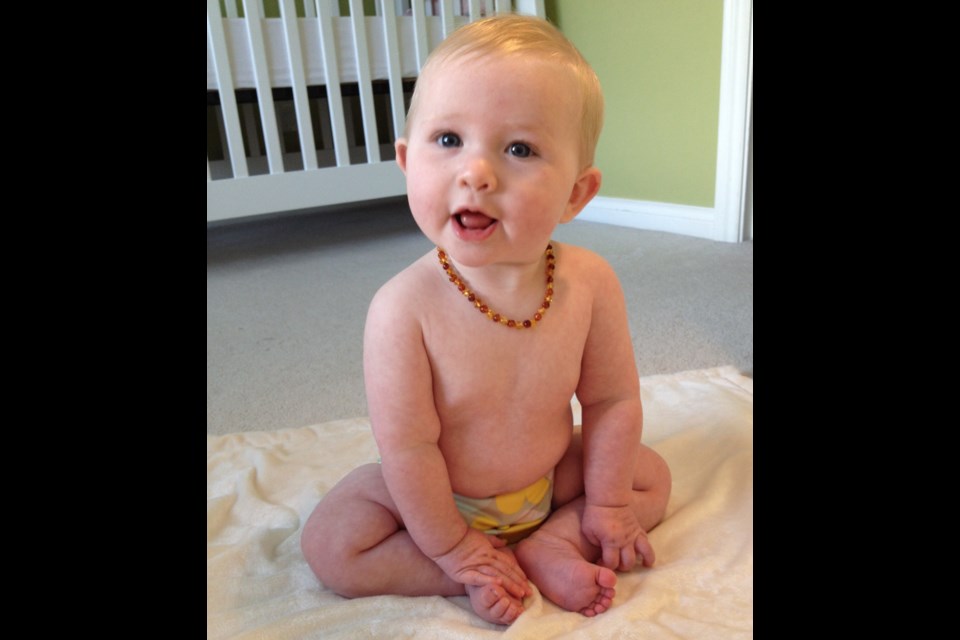A shark swims across the two-and-a-half-year-old’s bottom. Squamish’s Thorn Suttie is lying bottom up and an image from the movie Jaws is imprinted on the back of his cloth diaper.
His four-month-old little sister, Thistle, has “Merry Christmas ya filthy animal” written across her bright-red cloth diaper.
These are definitely not the cloth diapers of generations ago.
Gone is the folding, pins and the rubber pants of old. The new cloth diapers come with Velcro or snaps and in various shapes, sizes and colours.
“I say I kind of belong to a cloth diaper cult,” said Agnes Suttie, mom to Thorn and Thistle.
Suttie said she initially wanted to go with cloth to minimize her impact on the environment, but quickly got caught up in collecting the various designs.
According to the District of Squamish, household hygiene products – diapers and feminine products– make up between 17 and 30 per cent of Squamish’s total waste sent to the landfill.
It is estimated that more than four million disposable diapers are discarded in Canada each day, and it takes an estimated 200 to 500 years for disposable diapers to decompose in a landfill, say district staff.
In addition to being better for the environment, many Squamish parents also say they went with cloth diapers for their children because they are less expensive overall.
Professional seamstress Siska Rae Fox runs Bum Envy Cloth Diapers in Toronto but sells to moms around the globe, including to some in Squamish, such as Suttie.
Fox was surprised at how successful her online store quickly became.
“After one week of opening my store, I was sold out,” she said.
Her diapers have become like trading cards among parents, she added.
“They haven’t lost value. They are tradable and re-sellable,” Fox said. “In a sense you are just temporarily renting them.”
Suttie agrees.
“Even if you put money into the diapers a lot of the time you can sell for a pretty decent chunk of change,” Suttie said, adding she also likes the idea of the jobs created for work-at-home moms who predominately make and sell the cloth diapers.
Babies decked out in cloth diapers are called “fluff butts,” explained Squamish single-mom Brooke Reber.
“We just sort of refer to our kids as fluff butts,” Reber said with a laugh. Reber has always used cloth diapers on her 10-month-old son, she said.
Reber, 20, said one of her main motivations for using cloth on her now 10-month-old son, Killian Danger, was the cost savings. “It worked, we saved a lot of money,” she said.
Calculations vary widely depending on the style and on if the cloth diapers are bought new or used, but all of the sources The Squamish Chief researched found a savings with cloth.
Cloth diapers cost $984 over two years, including electricity, water and detergent, according to calculations by the environmental charity Green Action Centre. Disposable diapers purchased in bulk cost $1,309 over the same period.
Though there are plenty of parents who use cloth, Reber said she still gets quizzical looks at times when people find out she has her son in cloth 100 per cent of the time.
“They just look at you like, ‘That is nice, hippie,’” she said.
Reber said even her own parents told her they thought it would be too much work to go with cloth.
“But the way the new modern diapers are, they are as easy as disposables,” she said.
Squamish’s Kim Flynn also has her 18-month-old son in cloth.
She recommends a diaper sprayer to remove the feces off of the diapers.
“You basically attach it to the toilet and you turn it on through a valve,” she said, adding she also got a shield.
“It is like a clipboard with a shield that goes around. You clip the diaper into it and then you spray right into the toilet.”
It keeps hands away from the mess.
“It makes it doable,” Flynn added. “You are not disgusted.”



